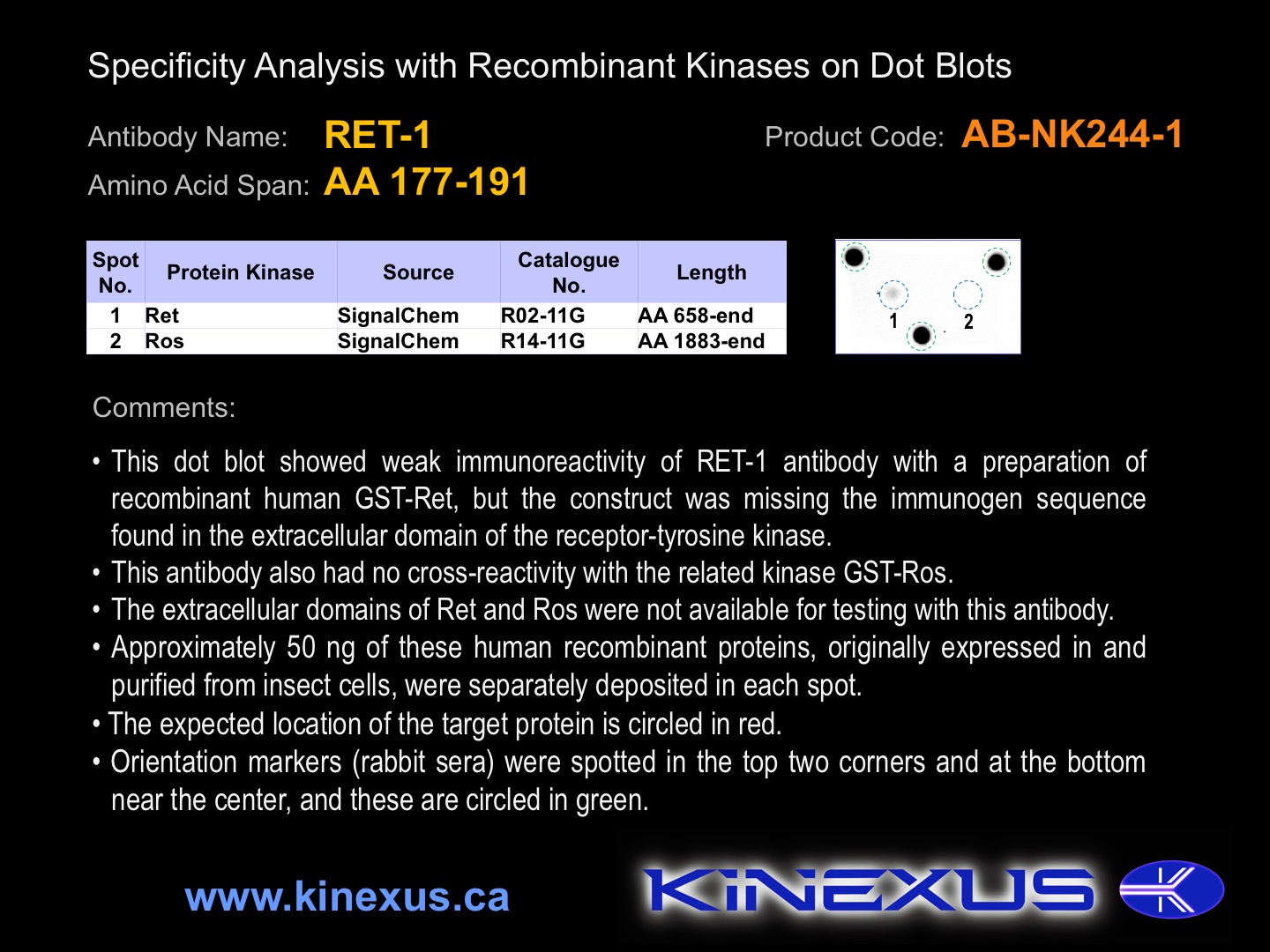Product Name: Ret-1
Product Number: AB-NK244-1
| Size: | 25 µg | Price: | 89.00 | |
| $US |
Target Full Name: Proto-oncogene tyrosine-protein kinase receptor Ret
Target Alias: CDHF12; C-ret; GDNF receptor; Glial cell line-derived neurotropic factor receptor; HSCR1; MEN2A; MEN2B; MTC1; PTC; Ret51; Ret-ELE1; CCDS7200.1; ENSG00000165731; B4DGX8; O43519; Q8IZR8; Q8NFE8; Q99886; Q9UM90; Q9UMQ4; F5CNE9; Q14277; Q15300; Q9UE13
Product Type Specific: Protein kinase pan-specific antibody
Antibody Code: NK244-1
Antibody Target Type: Pan-specific
Protein UniProt: P07949
Protein SigNET: P07949
Antibody Type: Polyclonal
Antibody Host Species: Rabbit
Target Alias: CDHF12; C-ret; GDNF receptor; Glial cell line-derived neurotropic factor receptor; HSCR1; MEN2A; MEN2B; MTC1; PTC; Ret51; Ret-ELE1; CCDS7200.1; ENSG00000165731; B4DGX8; O43519; Q8IZR8; Q8NFE8; Q99886; Q9UM90; Q9UMQ4; F5CNE9; Q14277; Q15300; Q9UE13
Product Type Specific: Protein kinase pan-specific antibody
Antibody Code: NK244-1
Antibody Target Type: Pan-specific
Protein UniProt: P07949
Protein SigNET: P07949
Antibody Type: Polyclonal
Antibody Host Species: Rabbit
Antibody Immunogen Source: Human Ret sequence peptide Cat. No.: PE-01AVA99
Antibody Immunogen Sequence: CRENRPPGTFHQFRLL
Antibody Immunogen Description: Corresponds to amino acid residues R177 to L191
Production Method: The immunizing peptide was produced by solid phase synthesis on a multipep peptide synthesizer and purified by reverse-phase hplc chromatography. Purity was assessed by analytical hplc and the amino acid sequence confirmed by mass spectrometry analysis. This peptide was coupled to KLH prior to immunization into rabbits. New Zealand White rabbits were subcutaneously injected with KLH-coupled immunizing peptide every 4 weeks for 4 months. The sera from these animals was applied onto an agarose column to which the immunogen peptide was thio-linked. Antibody was eluted from the column with 0.1 M glycine, pH 2.5. Subsequently, the antibody solution was neutralized to pH 7.0 with saturated Tris.
Antibody Immunogen Sequence: CRENRPPGTFHQFRLL
Antibody Immunogen Description: Corresponds to amino acid residues R177 to L191
Production Method: The immunizing peptide was produced by solid phase synthesis on a multipep peptide synthesizer and purified by reverse-phase hplc chromatography. Purity was assessed by analytical hplc and the amino acid sequence confirmed by mass spectrometry analysis. This peptide was coupled to KLH prior to immunization into rabbits. New Zealand White rabbits were subcutaneously injected with KLH-coupled immunizing peptide every 4 weeks for 4 months. The sera from these animals was applied onto an agarose column to which the immunogen peptide was thio-linked. Antibody was eluted from the column with 0.1 M glycine, pH 2.5. Subsequently, the antibody solution was neutralized to pH 7.0 with saturated Tris.
Antibody Modification: Unconjugated. Contact KInexus if you are interest in having the antibody biotinylated or coupled with fluorescent dyes.
Antibody Concentration: 1 mg/ml
Storage Buffer: Phosphate buffered saline pH 7.4, 0.05% Thimerasol
Storage Conditions: For long term storage, keep frozen at -40°C or lower. Stock solution can be kept at +4°C for more than 3 months. Avoid repeated freeze-thaw cycles.
Product Use: Western blotting | Antibody microarray
Antibody Dilution Recommended: 2 µg/ml for immunoblotting
Antibody Species Reactivity: Human
Antibody Concentration: 1 mg/ml
Storage Buffer: Phosphate buffered saline pH 7.4, 0.05% Thimerasol
Storage Conditions: For long term storage, keep frozen at -40°C or lower. Stock solution can be kept at +4°C for more than 3 months. Avoid repeated freeze-thaw cycles.
Product Use: Western blotting | Antibody microarray
Antibody Dilution Recommended: 2 µg/ml for immunoblotting
Antibody Species Reactivity: Human
Antibody Positive Control: The observed molecular mass of the processed target protein on SDS-PAGE gels is reported to be around 125-160 kDa.
Antibody Specificity: High
Antibody Cross Reactivity: No immunoreactivity on protein dot blots with recombinant human Ros.
Related Product 1: Ret-1 blocking peptide
Related Product 2: Ret-2 pan-specific antibody (Cat. No.: AB-NK244-2)
Related Product 3: Ret-3 pan-specific antibody (Cat. No.: AB-NK244-3)
Related Product 4: Ret-pY905 phosphosite-specific antibody (Cat. No.: AB-PK793)
Related Product 5: IRS1 (891-902) KinSub - Insulin receptor substrate 1 (K891-G902) mouse, peptide; IGF1R protein kinase substrate peptide
Antibody Specificity: High
Antibody Cross Reactivity: No immunoreactivity on protein dot blots with recombinant human Ros.
Related Product 1: Ret-1 blocking peptide
Related Product 2: Ret-2 pan-specific antibody (Cat. No.: AB-NK244-2)
Related Product 3: Ret-3 pan-specific antibody (Cat. No.: AB-NK244-3)
Related Product 4: Ret-pY905 phosphosite-specific antibody (Cat. No.: AB-PK793)
Related Product 5: IRS1 (891-902) KinSub - Insulin receptor substrate 1 (K891-G902) mouse, peptide; IGF1R protein kinase substrate peptide
Related Product 6: IRS1 (891-902) KinSub - Insulin receptor substrate 1 (K891-G902) mouse, peptide; IGF1Rtide protein kinase substrate peptide
Related Product 7: RetSubtide - Ret protein kinase substrate peptide
Related Product 7: RetSubtide - Ret protein kinase substrate peptide
Scientific Background: Ret is a receptor protein-tyrosine in the TK group of protein kinases in the Ret family. It is highly expressed and widely distributed in most tested human tissues. Ret is activated by binding one of four structurally ligands (i.e. GDNF, neurturin, artemin and persephin). Autophosphorylation of S696, Y806, Y809, Y864, Y900, Y905, Y928, Y952, Y981 and Y1062 of Ret increases its phosphotransferase activity. Phosphorylation of Y1015 inhibits its phosphotransferase activity. Protein interactions are induced with phosphorylation of Y981 (with Src), Y1062 (with Crk, Dok6, FRS2, Gab1, IRS1, PIK3R1, RapGEF1, Shc1 & Shc3), and Y1096 (with Grb2 & PIK3R1). Phosphorylation of Y1015 inhibits kinase activity. Ret orchestrates intestine organogenesis. Germline mutations of Ret cause a dominantly inherited dysgenesis of the enteric nervous system known as Hirschsprung's disease. Ret can undergo oncogenic activation by cytogenetic rearrangement. It is constitutively activated by point mutations in hereditary medullary thyroid carcinomas (MTCs). Multiple endocrine neoplasia type 2A (MEN 2A) is associated with two mutations of Ret. It was identified as a potential low-penetrance gene for apparently sporadic pheochromocytoma. Ret has also been linked with congenital central hypoventilation syndrome, bladder carcinomas, and colorectal adenocarcinomas.
© Kinexus Bioinformatics Corporation 2017


